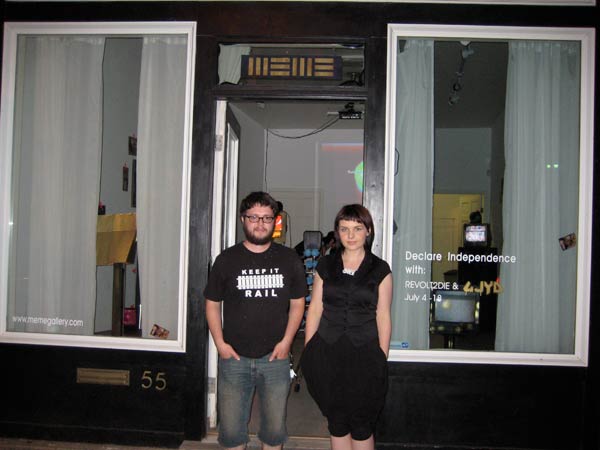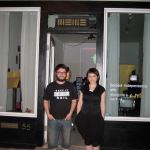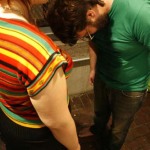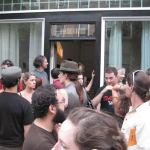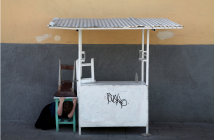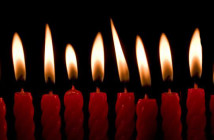Performance artists Phil Fryer and Sandrine Schaefer are the duo behind "The Present Tense", a series of festivals promoting performance art. Recently, they have joined forces with Vela Phelan, Dirk Adams, Alice Vogler and Brad Benedetti to create MEME, a gallery for performance-based art in Cambridge, MA. We met to talk about the new space, and its impact on performance art in Boston.
----
MN: Can you tell me about MEME, and how it got started?
SS: In November, we did a show together called "Congratulations On Your Empire" and a couple of our friends were running this space. It was called 55 Gallery then, and it was time for their lease to come up. They weren't sure if they wanted to continue the lease, but they wanted the space to continue as a gallery, so they asked us if we wanted to take it over.
Brad Benedetti, who had been involved with them, came on. We also brought in Vela Phelan, Alice Vogler and Dirk Adams -- who we worked with in TEST before. So we all decided to open this space.
MN: Is the space donated, or is it a lease?
SS: We're renting it, but it's affordable and with six of us it is really manageable -- monetarily and also for keeping it active.
MN: It can be hard to keep that energy up with a handful of people.
PF: Exactly.
MN: Are you a non-profit space, a for-profit gallery...
PF: We're just paying rent right now, and it just fell in our laps because the people who were doing 55, when their lease ran out they just said "You guys seem to respond well to the space. What do you think about taking over?" We literally had a month to decide, so we just signed the lease and if it becomes for-profit, that's great.
SS: Yeah, we have not even gotten that far yet.
PF: We've just done our best to get it up and running, and to book shows.
SS: We're on our second show now, which is "Revolt2Die", PrincessDIE and GJYD's "Declaration of Independence" project.
PF: Lot's of very mysterious things...
SS: Very mysterious names.
PF: The first show was really fun, and something that we had been wanting to do for a long time. Actually, it was a concept that Sandi worked on for a show a while ago that never really found a space for it to happen. That was the "Accumulation" show...
SS: So, we wanted to have different artists to come in, at different times, and do a series of creative actions. They would leave their remnants, and each artist would have to work with the remnants of someone else, and built upon it. So the result would be this crazy evolving installation that was also performance documentation. What we decided to do was to have all the artists who are the curators of MEME do the show together.
PF: It was a great way to kind of warm up and interact with everyone. We've worked with Dirk, Alice and Vela before. Brad is a very good friend of ours, but we've never organized anything with him. He comes from RISD and we all come from the Museum School, so there's a kind of wild card this time, and it is really interesting to have somebody bring something really different to the table. It really established how we all work together.
SS: It brought out the potential of the space too.
MN: Now, both of you created work here when it was 55 Gallery, so you already have a relationship with the space itself. Have you found that helpful as you plan shows and events?
PF: We had such a good time responding to the space, and we were lucky that when we did "Congratulations On Your Empire" we had three weeks beforehand to prepare, when we could get into the space and build the entire show here. So we're working off that model, giving people the opportunity to spend time with the space, and respond to it and really activate it. There's something really special and unique about that.
MN: So MEME is a small, brick building on a side street near Central Square in Cambridge...
PF: We think it used to be a travel agency. It has a storefront with nice windows.
MN: ...and I know you often do performance work that is very durational, sometimes eight or ten hours at a time, or longer. Dirk Adams also does durational work. How much does the location of the space, and its ability to bring people into these long-form works, affect the programming you are planning? Have you figured out a way to take advantage of your visibility?
SS: Absolutely. I think the windows are huge, and we've already seen a number of artists working with the windows all the time. We did it with our first show, PrincessDIE is using them for this show. People will watch the gallery from across the street, and that makes the space unique. We've had a lot of people from the neighborhood come in, we've had kids come in, and just interact with the art.
PF: We're really lucky to be so embraced by this neighborhood. People are very excited to see this space doing something. They are a little hesitant to come inside sometimes, but it's accessible and you can see the space from the street so we're using that as an access point to get people to come in. We want to make sure that anyone, even someone passing by, can look in and see the work and experience what is happening. Performance, in particular, is good for that -- the "Accumulation" show in particular -- because people just got used to new stuff happening every day.
MN: Let me home in on that word "performance" for a second. I know that the list of people involved in the space are all primarily known as people who do performance work, so it seems as if that would be your intention with the space. Do you see that as a boundary for your programming, or will it eventually be a space with paintings on the walls and more conventional art practice?
SS: I think it depends on the work. Already, we've broken out of our shells and started thinking about work that is more object-based. For us, what we have talked about a lot, is that we really want the space to be active. We're finding already with some of the artists we've decided to show, it's not how we used to define "active," but it is active. I don't know how conventional it will ever be, it'll probably never be conventional, but it will be a place for challenging work.
PF: We've entered a different phase for us, because we were in Fort Point for so long and we had access to those spaces in Midway Studios for such a long time. We really exploited those.
SS: We did nine events there.
PF: But those were always one-night things, so we'd have five Boston artists and maybe two traveling artists. Everybody would converge at once, see the show and then that would be the end. So, it's just a different phase for us to take someone who can make performative work and say "Well, you can rock a performance for one night, why not try it for ten days and see what happens?" We're picking artists that we love and trust, and just letting them do what they need to do. Sometimes that means that even we don't know what might be coming, but there's an excitement in that.
- Phil Fryer and Sandrine Schaefer outside MEME Gallery
- Fryer and Schaefer during a performance.
- The crowd gathered outside MEME for a performance by GJYD.
MEME is located at 55 Norfolk Street, near Central Square in Cambridge, MA
Top two images are by the author. Bottom image courtesy of the artists.

